 |
|
Their Iberian predecessors include these
frieze figures from Santiago de
Compostele, Spain.
|
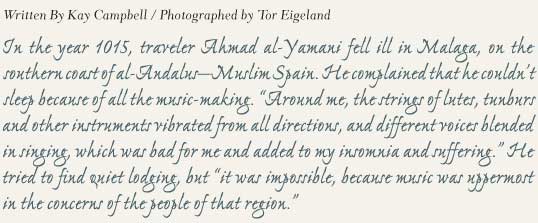
|
 ne of the world's most influential
musical cultures flourished from the
eighth to the 15th century in the southern
Iberian realm called al-Andalus by the
Arabs who lived and ruled there. Only
traces of that original music remain today,
in poems, written histories, illustrations
and oral traditions handed down through
generations, yet Andalusian music and its
many descendants still inspire performers
and audiences around the world.
ne of the world's most influential
musical cultures flourished from the
eighth to the 15th century in the southern
Iberian realm called al-Andalus by the
Arabs who lived and ruled there. Only
traces of that original music remain today,
in poems, written histories, illustrations
and oral traditions handed down through
generations, yet Andalusian music and its
many descendants still inspire performers
and audiences around the world.
Arabs have always considered the
music of al-Andalus a pinnacle of Arab
culture. It gave rise to poetry and song
forms that influenced the European
troubadours, whose music in turn became
part of the Renaissance, and is still
heard today.
Often attracted first by the romantic
reputation of al-Andalus, modern-day
musicians worldwide love to "reimagine"
its music, blending beautiful old Spanish
melodies with Middle Eastern, medieval,
flamenco and gypsy influences. Many
performers and audiences are also
inspired by the ideal of convivencia, the
complex co-existence that occurred
among Islamic, Jewish and Christian
cultures in al-Andalus.
Anthropologist Jonathan Shannon of
New York's Hunter College writes about
the music and culture of al-Andalus.
"Today, people look at our world full of
conflict, and romantically view the period
of al-Andalus as one of cultural tolerance
where Muslims, Jews and Christians all
got along and created wonderful poetry,
music, food and architecture. They think
that if we want to understand tolerance
today, let's look back to medieval Spain.
Some people see that as a potential loose
model for how the world should be."
Those people, he says, and many modern
Arabs as well, often see al-Andalus as
a "golden age." In Spain itself, after
centuries of willful forgetting of the
contributions of Muslims and Jews to
the national history, Spanish musicians
and artists have for some decades reveled
in a kind of willful remembering—and
re-mythologizing—of their multicultural
past.
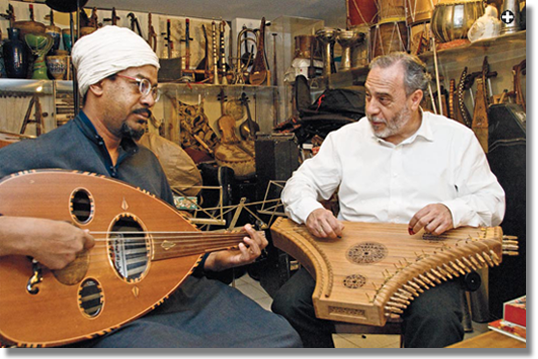
|
|
Echoing the Middle Ages from his Madrid
studio, Eduardo Paniagua plays a psaltery,
or lap harp, as longtime collaborator Wafir
Sheikh el-Din plays an 'ud, or fretless lute.
Their Iberian predecessors include the illustration,
below, that Paniagua chose for the cover
of one of his most popular recordings,
"The Best of the Cantigas."
|
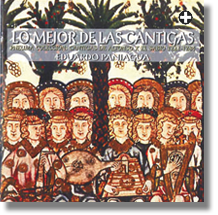
|
For Madrid musician, architect and recording producer
Eduardo Paniagua, reimagining the elusive music of
al-Andalus is a lifelong passion that has led him
on a musical journey across continents, centuries
and cultures. Blending a kind of musical
archeology with his own imagination,
Paniagua has spent decades teasing out
musical threads from the past and weaving
them into something new and alive.
He plays on both medieval Spanish and
modern Middle Eastern instruments. He
hunts for songs and poems in old manuscripts,
finds inspiration in poems on
palace walls and studies images of musical
instruments in drawings and carved
reliefs. He seeks out living masters of
Arab music in North Africa and rescues
historic recordings from oblivion.
"It's a joy to be able to do this work,"
Paniagua reflects. "Yet I don't know why it
entered me. I don't know why I have this
love of Arab music and early music. I only
know that I love it."
 |
 usic was an integral part of daily
life in al-Andalus, from the first
days the Arabs arrived in 711 until years
after the last Arab ruler was expelled from
Granada in 1492. Holidays and weddings
were incomplete without music and dancing.
Professional singers, male and female,
were attached to aristocratic homes and
royal courts. Al-Andalus's most famous
musician was Ziryab, originally from
Baghdad. After arriving in Córdoba in
822, he established a music school and
set down rules for classical music
performances. These suites of vocal and
instrumental music are known now as
the nubah. He is best known for innovating
the tuning and playing of the 'ud, the
unfretted lute, Arab music's signature
string instrument and predecessor of
the modern guitar. Especially in Seville,
craftsmen refined and invented musical
instruments. Polymath thinkers wrote
about music theory. Andalusian musicians
developed their own interpretations of the
maqamat, or modes and scales, that grew
distinct from those of the eastern Arab
world. Around the year 1000, when the
original Andalusian caliphate splintered
into smaller states, two new forms of
popular poetry sprang up and were set to
music: muwashshah and zajal.
usic was an integral part of daily
life in al-Andalus, from the first
days the Arabs arrived in 711 until years
after the last Arab ruler was expelled from
Granada in 1492. Holidays and weddings
were incomplete without music and dancing.
Professional singers, male and female,
were attached to aristocratic homes and
royal courts. Al-Andalus's most famous
musician was Ziryab, originally from
Baghdad. After arriving in Córdoba in
822, he established a music school and
set down rules for classical music
performances. These suites of vocal and
instrumental music are known now as
the nubah. He is best known for innovating
the tuning and playing of the 'ud, the
unfretted lute, Arab music's signature
string instrument and predecessor of
the modern guitar. Especially in Seville,
craftsmen refined and invented musical
instruments. Polymath thinkers wrote
about music theory. Andalusian musicians
developed their own interpretations of the
maqamat, or modes and scales, that grew
distinct from those of the eastern Arab
world. Around the year 1000, when the
original Andalusian caliphate splintered
into smaller states, two new forms of
popular poetry sprang up and were set to
music: muwashshah and zajal.
As the centuries passed, the musical
and poetic ideas of al-Andalus spread
north into Europe, south into North
Africa and east into Egypt and beyond.
Later, after 1492, additional waves of
exiles from the Muslim and Jewish communities
of al-Andalus moved to North
Africa and points east, bringing with
them music and poetry, while those Arabs
and Jews who remained in Spain kept
making their own style of music until
speaking and singing in Arabic were officially
banned in the 16th century.
Though most books on Andalusian
music theory were lost, anecdotes about
that musical world point to its exuberance.
Some old muwashshahat poems survived,
and they are still sung in Egypt, Lebanon
and Syria. The classical nubah vocal and
instrumental suite tradition incorporated
many muwashshahat, and the poems
live on in the nubah tradition, mainly in
Morocco, Algeria, Libya and Tunisia.
The trouble for musicians today is
that they can't be certain that the repertoires
performed by modern ensembles in
North Africa and the eastern Arab world
in fact use the same melodies once played
in al-Andalus, or even close approximations.
There are simply no written musical
scores of music from Andalusian
times. Musicians in medieval Europe
and the Middle East didn't help the situation
either, since they regularly set old
poems to new melodies, and
new poems to old melodies.
Thus a muwashshah heard
in Egypt today might be set to
an old Andalusian poem, but
the melody may be only 100
years old.
Folklore and music historian
Dwight Reynolds has
been studying the music of
al-Andalus and North Africa
for two decades. "It is quite
probable that a large part of
the Andalusi music repertoire
is old. We just can't tell which
part," he says.
This allows—or forces—modern musicians who
attempt to revive the sounds
of al-Andalus to make many
bold choices and judgments
that inevitably open them
up to criticism. First, they
must select repertoire from
the living, mostly North African, traditions
or from written traces of "lost"
music. Then they must decide whether
to perform in a large ensemble (such
as the modern groups in North Africa)
or in a smaller group (such as a typical
eastern Arab ensemble), or to follow
historic Arabic sources that usually
describe a solo singer accompanied by a
single instrument. Musicians also have
to decide whether they'll play modern or
antique instruments, and then they must
also choose rhythmic and vocal stylistic
interpretation.
 or Paniagua, such uncertainty has
become familiar territory, and one
key to his enduring passion, he says, is
that it started early, at home. Born in 1952
in Madrid to an unusually musical family,
Paniagua was the son of a well-known
hematologist who collected records and
filled the house with music played on the
family record player.
or Paniagua, such uncertainty has
become familiar territory, and one
key to his enduring passion, he says, is
that it started early, at home. Born in 1952
in Madrid to an unusually musical family,
Paniagua was the son of a well-known
hematologist who collected records and
filled the house with music played on the
family record player.
"We loved all kinds of music, not only
classical," Paniagua says, smiling. "And in
our house there
was no television.
Only music."
Eduardo is the third of four brothers:
Gregorio and Carlos are older
and Luis younger. Gregorio studied cello
at the Madrid conservatory, and as boys
the three younger Paniagua brothers also
picked up instruments. In the early 1960's,
Gregorio became fascinated with the
early-music movement in Europe and
the us.
In 1964, when Eduardo was 12,
Gregorio formed a band called Atrium
Musicae ("The Music Court") that included
his brothers. They began to perform
medieval music on period instruments,
using historic drawings and paintings as a
guide. The group first performed in local
high schools, and gradually expanded to
museums and theaters.
"It was a golden age in the family," recalls Luis.
The Paniagua brothers made their first
recordings in 1969. Eventually they made
22 records, including an album of classical
Greek music based on notations on papyrus
fragments. The group toured Europe
and the us,
and in 1972 it performed at
New York's Metropolitan Museum of Art.

|
|
Together Paniagua and Sheikh el-Din have toured and collaborated with dozens
of musicians and groups since the 1990's. |
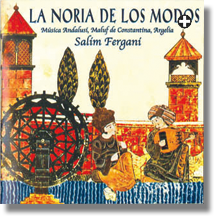 |
Medieval artworks are characteristic elements
on the covers of Pneuma's more than 120 recordings.
Such art tells us much about and how music was performed.
|
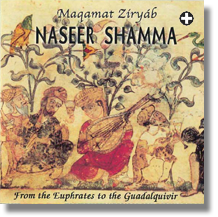
|
Luis Delgado is another prominent
Spanish musician who finds inspiration
for his many compositions and recordings
in the musical heritage of al-Andalus. As
a young man, he performed and recorded
with Atrium Musicae. "I have a very positive
feeling from that time," he recalls.
Gregorio, he says, "opened our minds to
early music with a concept of freedom
and joy."
During the heyday of Atrium
Musicae, Eduardo and his brothers first
encountered the classical music of North
Africa. Eduardo recalls that Gregorio
heard some recordings and, while on his
honeymoon in Morocco, sought
out masters of the traditional
music known as ala, the local
term for the nubah. Gregorio
later brought the highly regarded
classical Tetouan ensemble of Abd
al-Sadiq Shiqara to Spain to record
courtly music from the 12th and 13th centuries.
The connections that the Spanish members of
Atrium Musicae made with their Moroccan counterparts
launched them into a far more profound series
of encounters with the music of al-Andalus and
North Africa. Just three years later, Atrium Musicae
recorded instrumental selections from the North African
repertoire played on medieval Spanish instruments.
After Atrium Musicae disbanded in
1984, Eduardo, Carlos and Luis Paniagua
formed Calamus, a group that also
included Luis Delgado and Begonia Olavide,
whose specialty was the psaltery,
or medieval lap harp. Calamus produced
two cds
using medieval Spanish and Arab
instruments, which reflected their growing
knowledge of the traditions.
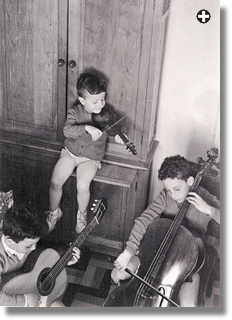 |
|
COURTESY EDUARDO PANIAGUA |
| Growing up in Madrid with
brothers Luis (center), Carlos
(right) and Gregorio (not shown),
Eduardo (left) recalls, "We loved
all kinds of music, not only
classical. And in our house there
was no television. Only music." |
Reynolds has followed these musicians
over the decades. "If their first efforts now
seem uninformed, much to their
credit they all took it very seriously,
and for a couple of decades
now have pushed further and
further into the tradition. They
could have stopped with the type
of music they were doing in the
1970's, but they didn't. They kept
on studying, and they kept on
collaborating."
Carlos married Olavide, and
the couple now lives in Tangier,
where he works as a luthier of
early string instruments, working
from medieval illustrations and
other artwork. He and Olavide
regularly perform, record and collaborate
with Moroccan musicians.
Gregorio went on to pursue
both his own musical projects
as well as fine art. Luis Paniagua
became a well-known sitar player
who also, these days, plays a
classical Greek lyre made by his
brother Carlos.
Eduardo began to focus on the
production of recordings. In
1994, he founded his own label,
Pneuma, which means "spirit"
in Greek. By early this year,
Pneuma's output had surpassed 120
cd's,
a pace of some eight to 10 each year in
a prolific, wide-ranging exploration of
music in medieval Spain, North Africa
and, increasingly afield, in the eastern
Arab world. For bringing so much of this
music to the broader public, the Academy
of Spanish Music has nominated Paniagua
three times for its Best Classical Musical
Artist award.
For Delgado, "Eduardo's work in recent
decades has been of enormous importance
for the dissemination and knowledge of
Andalusian music, not only in Spain, but
in Europe. His recordings include not the
new interpreters of this music, but
classical recordings of performers and
styles that have received little attention
in other previous labels. Thanks to Pneuma,
these recordings are now available."
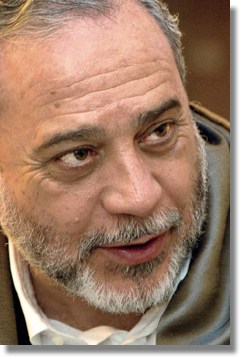 |
|
"It's a joy to be able to do this work. Yet
I don't know why it entered me. I don't
know why I have this love of Arab
music and early music. I only know
that I love it," Paniagua says. |
One of Paniagua's first recording
quests is also his most ambitious,
a still-unfolding journey that, if he
completes it, will mark an unprecedented
feat: Initially under contract with
Sony, and later on Pneuma's label, he
has set out to record all 420 songs of the
13th-century songbook known as the
"Cantigas de Santa Maria," which was
compiled in Toledo under the patronage
of King Alfonso x.
These songs chronicling the miracles of the Virgin Mary are
a mosaic of the region's traditions, Paniagua
says, making them an exceptionally
rich source for exploring Spain's medieval
music. Not surprisingly, the "Cantigas"
are popular with early music ensembles worldwide.
Although no one knows for sure precisely
which instruments were originally
used to perform the "Cantigas," detailed
illustrations in surviving manuscripts
give a surprising amount of detailed
information. They also often depict
Arab and European musicians playing
together. Alfonso almost certainly had
Arab musicians in his court: Nine years
after his death, his son employed 27
salaried musicians, including 13 Arabs,
two of whom were women. Like other
early music ensembles around the world,
Paniagua's group, Musica Antigua, began
to experiment with Arab rhythms and
instruments in performances and recordings
of the "Cantigas," seeking a balance
between interpretive historical fidelity
and sounds that can please modern
ears, too.
As he continues to work through the
"Cantigas," Paniagua has also recorded
North African groups playing the classical
nubah suite music of Morocco,
Algeria and Tunisia, and joined with
other Spanish and Arab musicians to
play combinations of medieval period
and modern Middle Eastern instruments.
They recorded several popular nubat
and named their trans-Mediterranean
group Ibn Baya, after one of Paniagua's
most admired Andalusians: philosopher,
scientist, composer and musician Ibn Bajjah,
also known as Avempace, who lived
in the late 11th and early 12th centuries.
The years of study and practice that
Paniagua and his Spanish colleagues had
invested came to fruition in these recordings:
talented musicians, a perfect blend
of instruments, a careful choice of repertoire
and high production values. (See
"A Pneuma Sampler.")
"I learned a lot from the Ibn Baya
recordings," Paniagua says. "The music
of North Africa is a living tradition, not
fixed. It sounds different at home or at a
wedding. And the poetry is very important.
It's the expression of the music, and
they can change one bit of poetry for
another."
 n Paniagua's home studio in suburban
Madrid, hundreds of musical
instruments from around the Mediterranean
fill two walls of floor-to-ceiling
display cases. A large collection of
lps and
books about the Middle East and its music
flank the others.
n Paniagua's home studio in suburban
Madrid, hundreds of musical
instruments from around the Mediterranean
fill two walls of floor-to-ceiling
display cases. A large collection of
lps and
books about the Middle East and its music
flank the others.
He picks up a medieval lap harp, a
two-winged psaltery made by his brother
Carlos from an illustration from the 13th
or 14th century. He begins to play an old
Andalusi tune from North Africa. A multiinstrumentalist,
Paniagua also plays the
qanun, the plucked zither of the Arab world
and Turkey. On both psaltery and qanun,
he explains, he deliberately uses simple
plucking techniques and a pared-down
ornamentation that he believes would have
been prevalent in medieval times.
Later, he plays an improvisation on
the Eastern European flute, the kawala.
Though he also plays the end-blown reed
flute of the Arab world called nay, Paniagua
chooses to use the kawala when he's
performing medieval Spanish music: It
sounds better to modern ears when playing
the scales of North Africa and medieval
Spain, he explains.
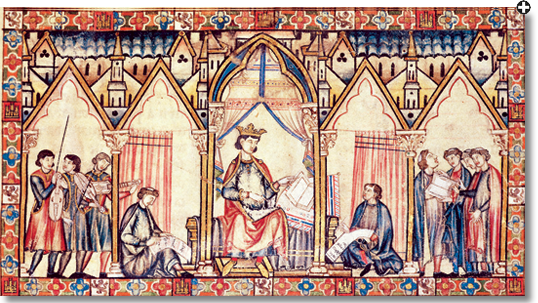 |
|
BIBLIOTECA MONASTERIO DEL ESCORIAL / BRIDGEMAN ART LIBRARY |
|
A 13th-century illustration accompanying one of the
"Cantigas de Santa Maria" includes musicians in the court
of King Alfonso x. |
A frequent collaborator with Paniagua
is Wafir Sheikh el-Din, a Sudanese
singer and 'ud player living in Madrid
who brings his Arab background to many
of Pneuma's projects. An early member
of the popular world-music band from
southern Spain, Radio Tarifa, which
blended Spanish and Mediterranean
music, Sheikh el-Din was studying in
Madrid when he says he fell in love with a
recording by Calamus called "Splendours
of al-Andalus." He made contact with
Paniagua, who happened to be looking for
an 'ud player to join the Cantigas project.
Sheikh el-Din has worked with Paniagua
ever since on many recordings, touring
with him in the eastern Arab world.
"I love Eduardo's work," he says, "especially
as a producer, because he can take
scientific knowledge and turn it into an
actual experience. He knows how to put
something on the stage.
"I think the most important work
we do," he adds, "is the connection of
the three cultures—Jewish, Muslim and
Christian. This is the main dish for me,
because in my personal life, I dedicate
myself to make a connection with religion.
When we perform, we notice that
people are thirsty to find connections
between the cultures."
Paniagua's own thirst for the subject
has led Pneuma to produce cd's
exploring not only the three cultures of al-Andalus,
but also Gregorian and Catalonian chants,
Sephardic songs, songs about the famous
Battle of Arcos in 1195, the legend of El-
Cid and the legacies
of the troubadours.
Despite this musical range, Pneuma
recordings maintain a distinct graphic
style. This is where Paniagua the architect
comes in: He is deeply involved in the design of each
one, and the liner notes, which he writes
himself, are usually extensive enough to
require their own booklet.
The cd covers
and notes are all filled with abundant
period illustrations, many showing medieval
musicians. Most cd's
have their notes translated into both English and French.
"The music speaks for itself," Paniagua
says, "but what's really fascinating
is where it was found, where it comes
from, the history of it. Sometimes it
takes twice as long to do the texts as the
recordings, due to all the translations and research."
Alongside performing, recording
and producing, Paniagua's job with
Madrid's regional government connects
him to architecture much as he is
connected to music: He advises landowners in rural areas on
the restoration of old structures, especially
in villages and town centers; he catalogues
significant old buildings and tries to keep
them from being destroyed.
 |
|
Crafted by Paniagua's brother Carlos
to resemble such instruments as the
one appearing on the cover of
Pneuma's 2009 catalog, above, this replica medieval 'ud is on
display in Granada at the Pabellón
de al-Andalus y la Ciencia. |
 |
Indeed, some of Paniagua's most interpretive
recordings connect the music of
al-Andalus to its architecture.
The cd
"La Felicidad Cumplida" ("Perfect Bliss") sets
poetic inscriptions carved on the walls
of Seville's Alcázar Palace to traditional
al-Andalus melodies from North Africa.
It includes a song set to this builder's or
architect's prayer, which appears in 18
places in the Alcázar:
O my trusted Friend! O my Hope!
You are my Hope; you are my Protector!
Bless my work with Your Seal of Approval.
Similarly, the cd
"Mudejar Builders" celebrates the multicultural history
evoked by the Church of St. Martin at
Cuellar, built in the 12th century by
mudejars, Arabs who lived in the Christian
territories of Spain before 1492. The
Alhambra Palace in Granada, too,
inspired several Pneuma recordings
featuring the verses of poets whose
words are inscribed on its walls. One
incorporates the soothing sounds of
the Alhambra's fountains in the background,
while another evokes three
stories from American author Washington
Irving's beloved book Tales of
the Alhambra.
Paniagua has also delved into the
music of Islam. The cd
"Al Muedano" ("Muezzin") features several versions
of the adhan, or call to prayer, including
a stirring choral version recorded
in the chanters' hall of the Umayyad
mosque in Damascus. He has also
made recordings of the religious associations
in Tangier singing Arabic
poetry of al-Andalus.
Pneuma is a small shop: Paniagua
works calmly with his longtime
sound engineer Hugo Westerdahl
in the Axiom sound studio off
Madrid's bustling Plaza Santa Ana,
where locals sample tapas late into
the night. The two men are putting
the finishing touches on another
unusual project: a recording made
using instruments sketched by Leonardo
da Vinci but never before built.
Three artists from around the world
built prototypes, including a lightweight
paper organ, a mechanical bowed instrument
with a keyboard known as a viola
organista and a silver viola with a neck
in the shape of a horse's head. Paniagua
says their challenge is to eliminate the
mechanical sounds the instruments make
while being played and to soften some
harsh tones coming from the viola.
Then they turn to Paniagua's next project:
a duet between 'ud and sitar with Iraqi
'ud master Naseer Shamma, who runs
a music school in Cairo. Paniagua is also
putting final touches on the latest "Cantigas"
disks—one about Jesus and another
of women's "Cantigas" featuring Samira
al-Qadiri, a singer from Tetouan, Morocco.
Playing a track from this recording, Paniagua
points out how her vocal timbre and
delicate ornamentation produce a different
overall sound than one hears from
western vocalists. Though it was challenging
for the singer to learn the melodies by
ear, Paniagua seems delighted
to present another approach to
the music of medieval Spain to
his listeners.
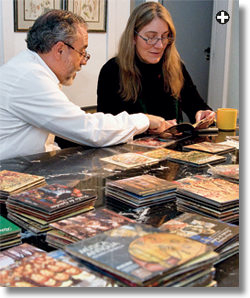 |
|
Paniagua shows liner notes to
writer Kay Campbell. In some
cases, research for a Pneuma
recording, he explains, takes
more time than production of
the music. |
 merican musician Bill Cooley recalls that it
was in the late 1990's that he
became fascinated with the
music of medieval Spain and came across
"Splendours of al-Andalus" by Calamus.
Although the music was compelling, he
says he was most intrigued by the blackand-
white photograph of instruments
that appeared on the back cover. "I used
to look at the photo with a magnifying
glass, wondering how the instruments
were made."
merican musician Bill Cooley recalls that it
was in the late 1990's that he
became fascinated with the
music of medieval Spain and came across
"Splendours of al-Andalus" by Calamus.
Although the music was compelling, he
says he was most intrigued by the blackand-
white photograph of instruments
that appeared on the back cover. "I used
to look at the photo with a magnifying
glass, wondering how the instruments
were made."
Inspired by the music and a growing
desire to learn to build medieval instruments,
Cooley traveled to Madrid to study
'ud with Wafir Sheikh el-Din, as well as
instrument-making. Sheikh el-Din soon
introduced him to Paniagua.
"I came here because of the work Eduardo does. It shows
on an international level what that means. He has created
a resource, not only for people in Spain, but internationally,
for people to study music that is no longer played so much
or recorded much. You can find other recordings of Andalusian
music from Morocco, Algeria and Tunisia, but you have to go
there to find them. So what Eduardo's doing when he records
these traditional groups is very important."
As Paniagua reaches the halfway mark of his quest to record
all of the "Cantigas"—which he estimates will total 60
cd's
in the end—he says he feels "freer and less guided by outside
criticism, because the work is there. If something comes
together really well, all the elements work. It's a complex,
intuitive world. The more you learn about history, the better
you can step ahead with your interpretations. Yet this music
is always a thesis. It's something you propose to do. I can
never put my hands in the fire and say with certainty,
'This is the way it was done.'"

 |
Kay Hardy Campbell
(www.kayhardycampbell.com)
lives near Boston, where she plays the
'ud and helps direct the annual
Arabic Music Retreat at Mount
Holyoke College. |
 |
Photographer and writer
Tor Eigeland
(www.toreigeland.com)
has covered assignments around
the world for Saudi Aramco World and other publications, and has
contributed to 10 National Geographic Society
book projects. |